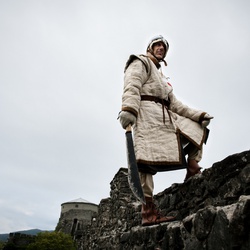Life in the castle: The Soldiers
Valle del Serchio. Più vicino a te

Little direct evidence has reached us concerning the life of the soldiers, castle governors and nobles inside the fortresses, but through indirect sources like the statutes, inventories and iconographic sources, it is possible to draw an extensive picture.
It is very clear that the castles and the fortresses were not only built for defence but were also places where many people lived, from soldiers to the castle governor and his family.
For the soldiers of any rank, life inside a fortress must have been very like reclusion, since they were obliged to remain inside the walls. They could only go out with a special license issued by the Elders of the Republic of Lucca, a rule not valid for the sergeants who had greater freedom of movement, being able to go out one by one on Mondays, Wednesdays and Saturdays unless a religious ceremony was scheduled.
The diet of the soldiers was centred on the consumption of bread, which had to be cooked in an oven inside the city walls, with the very occasional addition of meat. The day was marked by the bells that had the function of reminders of appointments and of recalling soldiers to their posts in case of attack.
From the documents in the archive of the Fortress of Verrucole, it is clear that the soldiers were lodged in uncomfortable conditions inside the "square fortress" while the lord lived in the “round fortress”. The garrison was equipped with light artillery, but lived under a regime of isolation, malnourished and under appalling health and sanitary conditions, to the point that Ludovico Ariosto, after an inspection of Garfagnana fortresses, wrote to Alfonso I that he found the Fortress "furnished only with all discomforts".
The conditions of the troops improved with the reorganisation launched by Marco Antonio Pasi (1579) who sought to house the soldiers in more comfort. During this phase of Estense domination, the soldiers were regularly paid an appropriate wage. We do not entirely know the quality of the diet at this time, but it certainly could not have been worse than the previous period since the basic foodstuff remained bread.
Starting from the seventeenth century, all the soldiers lived permanently inside the fortress, even for many years, and numerous accounts can be found in the parish archive of San Romano, which remind us of those who started a family after marrying women from the neighbouring town.
Life in the fortress at times of peace, therefore, could be enjoyed peacefully within a routine of drills in the correct use of the cannons and turns on watch; in the event of war, the defensive structures required action with soldiers of every rank employed in arming and aiming bombards and flintlocks.



